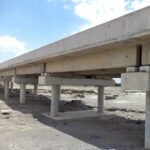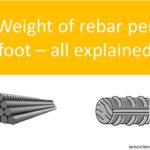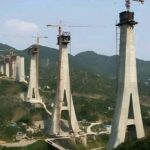Advanced wind engineering isn’t just about structures; it’s about comfort, safety, and unleashing architectural creativity.
But why put a building through a wind tunnel test, you ask?
Well, let me break it down for you – it’s about technical precision, economic savvy, safety assurance, and, dare I say it, aesthetics.
Today’s architects and engineers aren’t bound by convention; they’re pushing the boundaries with cutting-edge materials and groundbreaking designs.
Yet, while they’re busy dreaming up the future, wind loads provided in most codes are stuck in the past.
That’s where wind tunnel testing comes in, offering reliable data that leads to cost savings, peace of mind, and the freedom to innovate.
So, What are wind tunnels?
Wind tunnels are used for testing aircraft, spacecraft and car designs as well as air loads on structures like bridges, buildings, ship towers and high voltage transmission lines.
Its purpose is essential; wind tunnel testing ensures computers accurately predict forces exerted upon a structure by its surroundings.
But when should you consider a wind tunnel test?
Like Us on Facebook!
Early on, during the planning stages, when attention to detail can save time, money, and mitigate risks.
Subscribe Us on YouTube!
And if your project involves towering skyscrapers, unconventional designs, or unique surroundings, wind tunnel testing is not just advisable – it’s essential.
Wind Tunnels – but why?
Wind tunnels are test facilities that use controlled airflow to simulate the movement of air around a model or vehicle, creating an artificial wind current to determine aerodynamic forces acting upon it, such as lift, drag, lateral force components and pitching/rolling moments at various angles of attack which you can learn about here.
This information can help engineers design more energy-efficient and safer vehicles and aircraft.
The design of a tunnel must meet various criteria: maximum achievable speed, flow uniformity and turbulence level. A tunnel also needs to have an enclosed circuit with a closed test section for accurate measurements using pressurized air; additionally, its temperature needs to be strictly managed in order to protect instrumentation and models against heat-related effects.
For accurate testing, to achieve a highly uniform and laminar airflow, vanes must be employed to slow the rate of air entering the test section (source: https://www.grc.nasa.gov/www/k-12/airplane/tuntest.html). This ensures a steady velocity without too much kinetic energy reaching the model being tested. In addition, turbulent motion caused by fan blades should not interfere with accurate testing results.
Many tunnels can accommodate full-scale models, though for practicality and cost reasons most are designed for miniaturized ones. Once suspended on a force balance over the test section, lift, drag, lateral, and vertical forces are measured using various sensors and instrumentation devices.

How Do They Work?
Wind tunnels are long, straight tubes equipped with powerful fans at each end. The fans produce rapid airflow within the tunnel and engineers place test models into it to observe how they will respond. Some tunnels can be desktop-sized while larger structures enable engineers to test full-size aircraft or cars.
Tunnel fans can create considerable turbulence in the airflow, making it hard for engineers to accurately measure forces on models as they pass through it. To overcome this difficulty, engineers typically work with air quality consultants to employ “fog sheeting”, an engineering practice using water particles vaporized using ultrasonic piezoelectric nebulizers; once generated they can be moved over models using wind tunnel fans or illuminated using cameras or laser lights for measuring its movement.
Cars or their components are generally placed inside a tunnel with powerful fans creating controlled airflow around them, simulating driving conditions. The objects being tested in a wind tunnel could range from small models of an entire vehicle to individual components. Any test object must remain fixed for testing to allow test engineers to assess aerodynamic forces without worry that it is shifting or shifting during its study.
Measurements vary depending on the test; smoke can sometimes be added into the air stream to show how flow moves around an object while threads attached at specific points on an object may allow testing engineers to assess air pressure fluctuations there.
Some wind tunnel tests use a force balance that directly measures forces and moments on models in the wind tunnel, then converts that output signal into an angular acceleration measurement using sensors.
Other testing techniques rely on visual cues for analysis of airflow effects on models – smoke being an example; but oils and powders may also be used to mark areas on which laminar or turbulent flow occurs on models.

What Can Be Tested In Them?
Wind tunnel testing can be used to examine almost any object that can remain stationary within an airflow environment, including aircraft, cars, bicycles, spacecraft architectural elements, racing yacht keels. Tests may range from gentle breeze speeds all the way up to hypersonic velocities.
A particular test will depend on its objectives; accordingly, its size and type may vary accordingly. Some tunnels are large enough to accommodate full-sized aircraft while others are tailored towards easier to handle models with limited maneuverability.
Depending on which model is being tested, various flow visualization techniques such as free stream smoke analysis, laser sheet flow visualization, surface oil flows or shadowgraphs (schlieren systems) may be utilized to provide diagnostic information.
Wind tunnels can also be equipped with various instruments for measuring airflow like this around models or forces and moments being applied, as well as force and moment exerted upon them. Such instruments might include static pressure taps, total pressure rakes, laser Doppler velocimetry and hot wire velocity probes.
Wind tunnels can also be used to study forces or pressures acting on structures like buildings and bridges, through atmospheric boundary layer tunnels with long upwind sections that accurately represent air speed and turbulence.
Furthermore, these wind tunnels may feature pressure sensitive paint which changes color as forces acting upon models change or particle image velocimetry technology which monitors particles passing through an experiment site.

















